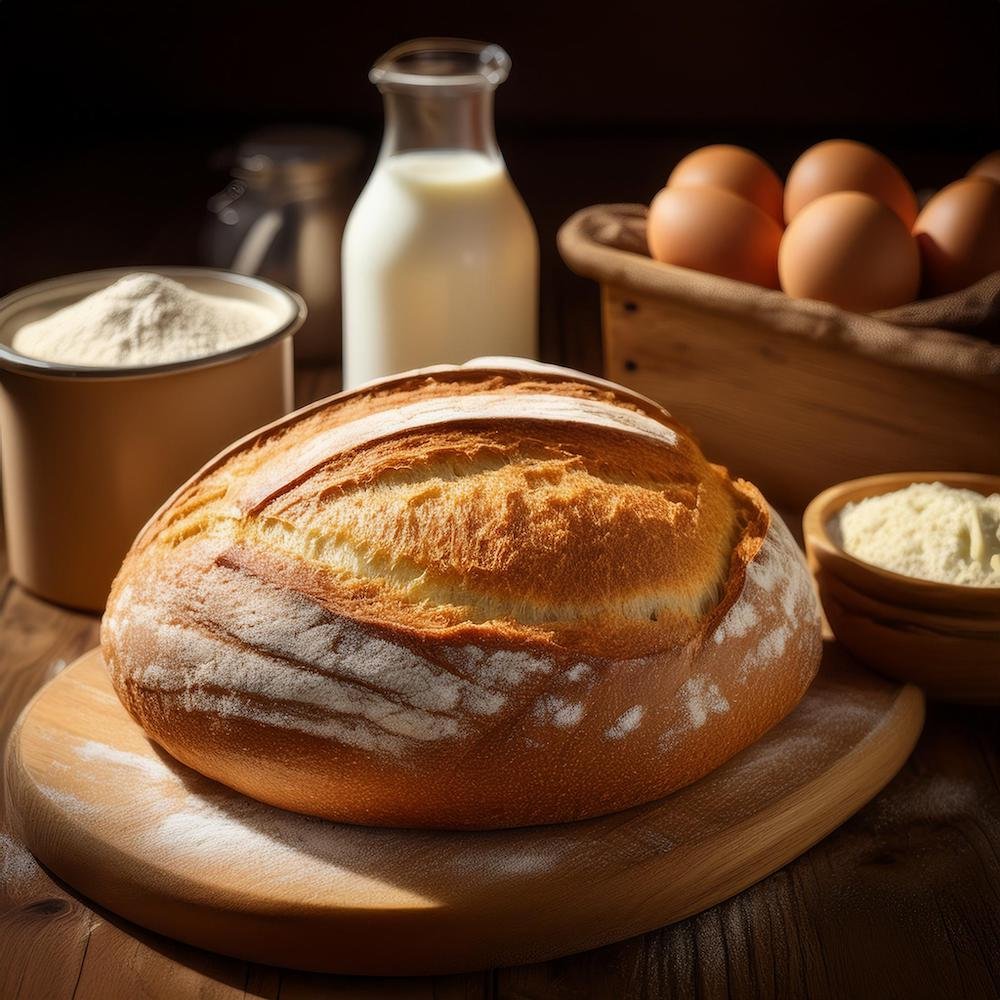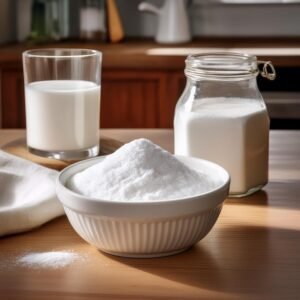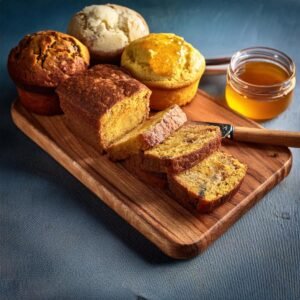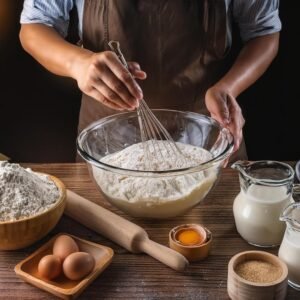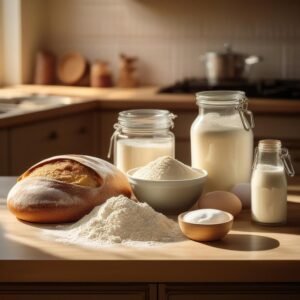Baking bread is an age-old tradition that has evolved into a science, with every ingredient playing a crucial role in achieving the perfect loaf. Baking soda, a common leavening agent, is often used in quick bread recipes to make the dough rise. But what happens if you don’t have baking soda on hand? Will bread rise without baking soda? The answer isn’t always straightforward. While some bread recipes can rise perfectly without baking soda, others may need careful adjustments to achieve a satisfactory result.
This blog explores the role of baking soda in bread-making, alternative leavening methods, how to adjust recipes, and the science behind rising dough. Whether you’ve run out of baking soda or are experimenting with new methods, this guide will help you understand what to expect and how to bake bread successfully.
Understanding Baking Soda and Its Role in Bread Baking
What Is Baking Soda?
Baking soda, or sodium bicarbonate, is a chemical leavening agent that produces carbon dioxide gas when combined with an acidic ingredient. The gas creates air bubbles in the dough, causing it to expand and rise. Unlike yeast, which requires time to ferment, baking soda acts quickly, making it a popular choice for quick breads like banana bread, soda bread, and certain muffins.
Why Is Baking Soda Used in Bread?
Baking soda, scientifically known as sodium bicarbonate, is a versatile and essential ingredient in many bread recipes, particularly quick breads. It is widely appreciated for its ability to transform dense doughs into light, airy loaves in a short amount of time. Let’s break down the three primary reasons why baking soda is often used in bread-making:
1. Leavening: Helping the Dough Rise
The most significant role of baking soda is as a leavening agent. When combined with acidic ingredients like buttermilk, yogurt, or vinegar, baking soda undergoes a chemical reaction that produces carbon dioxide gas. This gas forms small bubbles within the dough, causing it to expand and rise. Here’s how it works:
- Quick Reaction: Unlike yeast, which requires time to ferment, baking soda reacts almost immediately when mixed with an acid and exposed to heat. This makes it ideal for recipes that need to be baked quickly.
- Consistent Results: The gas production is predictable, ensuring the bread rises uniformly.
For example, in recipes like Irish soda bread, the combination of baking soda and buttermilk is what gives the bread its distinct rise and soft interior.
2. Neutralizing Acidity: Balancing Flavors
Baking soda not only helps the dough rise but also plays a crucial role in flavor development by neutralizing excess acidity in recipes that include acidic ingredients. Here’s why this matters:
- Flavor Balance: Without baking soda, bread with buttermilk, yogurt, or vinegar might taste overly tangy or sour. Baking soda helps to mellow these sharp flavors, resulting in a more balanced taste.
- pH Control: By neutralizing acids, baking soda raises the pH level of the dough slightly, creating a more alkaline environment. This contributes to the unique flavor profiles of certain quick breads.
For instance, when baking banana bread, the natural acidity of mashed bananas is neutralized by baking soda, enhancing the overall sweetness of the loaf.
3. Texture Enhancement: Ensuring Light, Fluffy Bread
Baking soda’s ability to produce gas doesn’t just help the bread rise; it also plays a vital role in improving texture:
- Soft Crumb: The carbon dioxide gas forms air pockets within the dough, resulting in a light and fluffy crumb structure.
- Tender Bite: By raising the pH of the dough, baking soda also weakens the gluten structure slightly, leading to a softer texture.
- Better Spread: In cookie-like quick breads, such as zucchini bread, baking soda allows the batter to spread evenly, creating a tender, moist final product.
Examples of Baking Soda in Action
- Banana Bread: Baking soda reacts with the acidity in mashed bananas and yogurt, helping the bread rise and achieve a fluffy crumb.
- Cornbread: In cornbread recipes, baking soda prevents the batter from being overly dense while balancing the flavors of buttermilk or other acidic liquids.
- Soda Bread: A classic example where baking soda reacts with buttermilk to create a soft, yet structured loaf without yeast.
In summary, baking soda is indispensable in bread-making for its leavening power, its ability to balance acidity, and its impact on texture. These qualities make it a go-to ingredient for quick breads and recipes that need a fast rise and light, flavorful results.
Will Bread Rise Without Baking Soda?
The short answer is yes, bread can rise without baking soda, but the results depend on the recipe. Here’s how:
Yeast as a Natural Leavening Agent
Traditional bread recipes use yeast instead of baking soda to make the dough rise. Yeast ferments sugars in the dough, producing carbon dioxide gas that creates air pockets. If your recipe relies on yeast, it will rise perfectly without baking soda.
Substitutes for Baking Soda in Quick Breads
If your bread recipe specifically calls for baking soda, you can try these substitutes:
- Baking Powder: Baking powder contains baking soda and an acidic component. Use three times the amount of baking powder as a substitute for baking soda.
- Self-Rising Flour: This type of flour has leavening agents already mixed in, making it a suitable alternative.
- Whipped Egg Whites: Adding whipped egg whites introduces air into the dough, helping it rise.
When Bread May Not Rise Without Baking Soda
In quick bread recipes that rely entirely on baking soda for leavening, skipping it can lead to denser, flatter loaves. Adjusting the recipe is crucial to achieving similar results.
How to Make Bread Rise Without Baking Soda
If you don’t have baking soda, there are several ways to encourage your bread to rise:
1. Use Yeast Instead of Baking Soda
Yeast is a reliable alternative to baking soda for leavening. While it takes longer to rise, the flavor and texture are often superior.
- How to Use It: For every teaspoon of baking soda, replace it with 1 tablespoon of yeast. Allow the dough to rest for at least 1-2 hours for proper fermentation.
2. Incorporate Baking Powder
Baking powder is a convenient substitute for baking soda because it already contains an acidic component.
- How to Use It: Use 3 teaspoons of baking powder for every 1 teaspoon of baking soda in the recipe.
3. Experiment with Natural Leavening Methods
Sourdough starters, made from fermented flour and water, can naturally leaven bread. This method requires preparation time but delivers incredible flavor.
- How to Use It: Replace baking soda with an equal amount of sourdough starter, adjusting the liquid content in your recipe as needed.
4. Add Whipped Egg Whites
Whipping egg whites introduces air into the dough, making it lighter and fluffier.
- How to Use It: Whisk egg whites to stiff peaks and gently fold them into the dough as the last step before baking.
Adjusting Recipes Without Baking Soda
When baking bread without baking soda, small adjustments can make a big difference in the final result:
1. Adjust the Liquid Ingredients
Substitutes like baking powder and sourdough starter may alter the dough’s moisture. Reduce or increase liquid ingredients as necessary to achieve the right consistency.
2. Add an Acidic Component
If using baking powder, which already contains an acidic element, reduce acidic ingredients like buttermilk or vinegar to prevent an overpowering tang.
3. Extend Baking Time
Bread without baking soda may require a slightly longer baking time to ensure it cooks evenly. Lower the oven temperature slightly to avoid overbrowning.
What Happens If You Don’t Add Baking Soda to Bread?
1. Texture Changes
Bread without baking soda may turn out denser and less airy. This is especially true for quick breads that rely solely on baking soda for leavening.
2. Flatter Loaves
Without the leavening action of baking soda, the bread may not rise as much, resulting in a flatter appearance.
3. Flavor Imbalance
Recipes with acidic ingredients might taste tangier or sourer without baking soda to neutralize the acidity.
FAQs
What happens if you don’t add baking soda to bread?
If you omit baking soda from bread recipes that require it, the bread may turn out denser and flatter, with an altered flavor profile. For recipes that use yeast or other leavening agents, the impact will be minimal.
Will dough rise without baking soda?
Yes, dough can rise without baking soda if other leavening agents like yeast, baking powder, or sourdough starter are used. However, quick breads that rely entirely on baking soda may not rise properly without it.
What happens if you bake without baking soda?
Baking without baking soda can result in dense, flat baked goods, especially in recipes that rely on it for leavening. Substituting with baking powder or other leavening methods can help.
How do you make flour rise without baking soda?
To make flour rise without baking soda, you can use self-rising flour, which contains leavening agents, or incorporate yeast, baking powder, or whipped egg whites as substitutes.
Tips for Successful Bread Baking Without Baking Soda
Focus on Texture: Whip egg whites or thoroughly cream butter and sugar to introduce air into the batter.
Experiment with Small Batches: When trying substitutes, bake small test batches to find the best adjustments for your recipe.
Don’t Skip the Rising Time: If using yeast or sourdough starter, be patient and let the dough rise fully before baking.
Conclusion
So, will bread rise without baking soda? The answer depends on the recipe and the leavening methods used. While some recipes, like those using yeast or sourdough starter, can rise beautifully without baking soda, quick breads may require substitutes like baking powder or whipped egg whites for a successful rise. By understanding the science of leavening and experimenting with alternatives, you can enjoy delicious homemade bread even without baking soda. Whether you’re improvising or exploring new techniques, the tips in this guide will ensure your bread turns out beautifully every time.
Table of Contents
Suggested Internal Links
- What Can I Use If I Don’t Have Baking Soda for Banana Bread?
- The Ultimate Guide to Banana Bread Recipe Without Baking Soda: Easy and Delicious
These articles provide additional insights and recipes that can guide you in baking without baking soda, ensuring your bread turns out delicious every time.
Craving more tasty recipes? Make sure to follow us on Facebook , Instagram, Pinterest, and Twitter for daily updates and kitchen inspiration!
